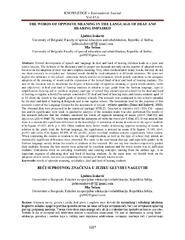Приказ основних података о документу
The words of opposite meaning in the language of deaf and hearing impaired
| dc.creator | Isaković, Ljubica | |
| dc.creator | Šešum, Mia | |
| dc.date.accessioned | 2021-11-29T13:54:23Z | |
| dc.date.available | 2021-11-29T13:54:23Z | |
| dc.date.issued | 2020 | |
| dc.identifier.issn | 1857-923X | |
| dc.identifier.uri | http://rfasper.fasper.bg.ac.rs/handle/123456789/3857 | |
| dc.description.abstract | Abstract: Slowed development of speech and language in deaf and hard of hearing children leads to a poor and scarce lexicon. The richness of the dictionary and its proper use depends not only on the number of adopted words, but also on the adoption of their true and complete meaning. Very often children know many words, but they do not use them correctly in everyday use. Adopted words should be used adequately in different situations. We must not neglect the influence of the school - education, family and the environment, which greatly contribute to the adequate adoption of the meaning of words and the expansion of the lexical fund of deaf and hard of hearing students. The aim of the research was to determine the degree of knowledge of opposite meaning of given words (nouns, verbs and adjectives) in deaf and hard of hearing students in relation to age, grade from the Serbian language, type of amplification (hearing aid or cochlear implant), and type of school they attend (special school for the deaf and hard of hearing or regular school).The sample consisted of 35 deaf and hard of hearing male and female students aged 11 to 15 (from the fourth to the eighth grade of primary school). The research was conducted in two schools attended by the deaf and hard of hearing in Belgrade and in one regular school. The instrument used for the purposes of this research is part of the Language Corpus for the assessment of lexical - stylistic specifics (Dimić and Isaković, 2003). The obtained data were processed in the statistical package SPSS.23. Descriptive statistics (AS i SD), Chi - square test and its significance were used. A qualitative analysis of the mistakes made was also performed.The results of the research indicate that the students mastered the words of opposite meaning of nouns (AS=4.51±0.85) and adjectives (AS=4.49±0.70), while they mastered the antonyms of verbs the worst (A=3.83±1,07). It was noticed that there is a statistically significant difference in the knowledge of antonyms of nouns in relation to the age of students (Chi-Square 15.627, df=8, p = .05). Older students have better results in knowing opposite meaning of nouns. In relation to the grade from the Serbian language, the significance is noticed in nouns (Chi-Square 11.443, df=4, p=.02) and verbs (Chi-Square 18.095, df =6, p=.01), where excellent students achieve significantly better results. When comparing the results in relation to the type of amplification, as well as the type of school they attend, no statistically significant differences were observed. We came to the conclusion that age and especially grades in the Serbian language mostly define the results of students in the research. We can say that teachers objectively graded their students, because the best results were achieved by excellent students and the worst results was in sufficient students. Continuous work on enriching vocabulary and forming concepts, starting from the earliest age, is an important segment of educating deaf and hard of hearing students. At the same time, we should work on the adoption of new words, but also on expanding the meaning of already known words. | sr |
| dc.language.iso | en | sr |
| dc.rights | openAccess | sr |
| dc.rights.uri | https://creativecommons.org/licenses/by-nc-nd/4.0/ | |
| dc.source | Institute of management and knowledge | sr |
| dc.subject | words of opposite meaning, vocabulary, deaf and hard of hearing students | sr |
| dc.title | The words of opposite meaning in the language of deaf and hearing impaired | sr |
| dc.type | article | sr |
| dc.rights.license | BY-NC-ND | sr |
| dc.citation.epage | 1233 | |
| dc.citation.issue | 6 | |
| dc.citation.spage | 1227 | |
| dc.citation.volume | 43 | |
| dc.identifier.fulltext | http://rfasper.fasper.bg.ac.rs/bitstream/id/4655/bitstream_4655.pdf | |
| dc.identifier.rcub | https://hdl.handle.net/21.15107/rcub_rfasper_3857 | |
| dc.type.version | publishedVersion | sr |


